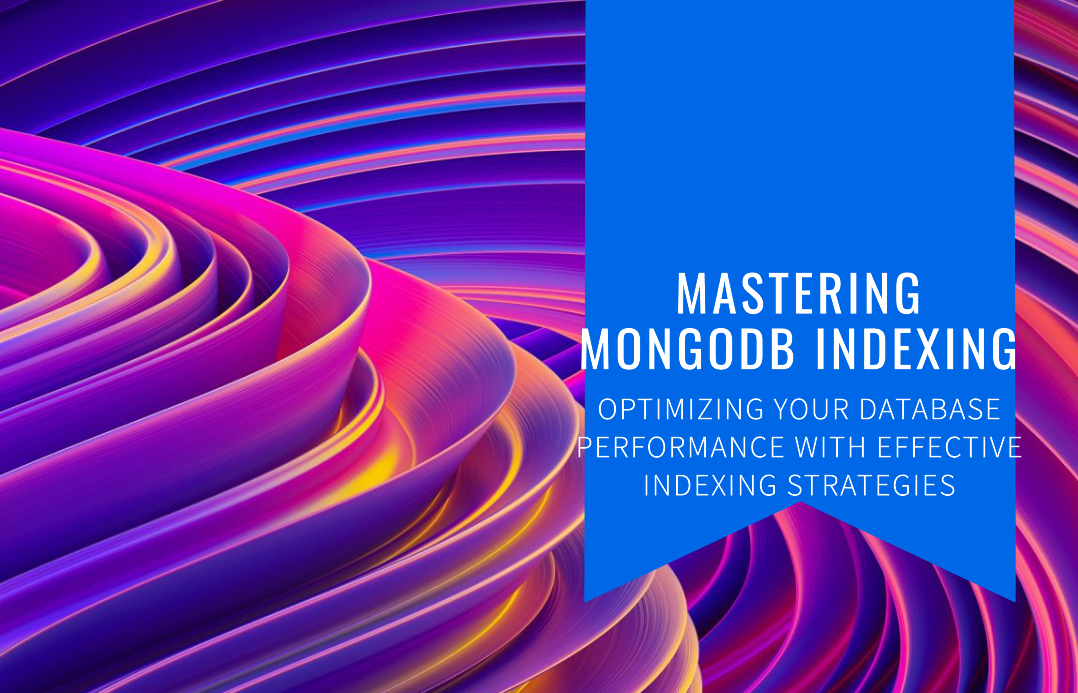Mastering MongoDB Indexes: A Guide to Boost Query Performance
 Abhiuday
Abhiuday
Introduction
Welcome to a comprehensive journey into the heart of MongoDB's performance optimization: indexes. While often working silently in the background, indexes are the unsung heroes that can drastically enhance the efficiency of your database operations. In this guide, we'll embark on an exploration of MongoDB's diverse index types, equipping you with the essential knowledge and skills to fine-tune your queries and supercharge your data retrieval. From unraveling the intricacies of index mechanics to mastering their strategic management, you'll emerge as a confident navigator of your MongoDB domain.
Understanding Indexes in MongoDB
In the realm of databases, indexes are your trusted navigational tools. They act as structured pathways, allowing lightning-fast data retrieval based on specific fields within a collection. Imagine them as the keys to unlock the doors of your data, saving you from scanning through countless records. By efficiently organizing subsets of data, indexes empower MongoDB to precisely locate the information you're looking for during queries.
Exploring MongoDB's Index Efficiency
Consider yourself in a vast library with endless bookshelves. To find a particular book, you consult the library's catalog, which leads you straight to the shelf. MongoDB's indexes function as your catalog, guiding you through the vast expanse of your data collection. They help you locate the exact documents you need without trawling through an entire dataset.
Creating an index in MongoDB is like mapping out well-marked paths within a labyrinth. When you establish an index on specific fields, MongoDB constructs a sophisticated guide that links field values to their precise locations in the collection. This strategic mapping enables MongoDB to sidestep the long routes, effortlessly pulling up documents that match your query requirements.
Throughout this guide, we'll delve into the captivating world of indexes, exploring their various types and understanding why they're indispensable for optimal database performance. We'll also address their limitations and reveal strategies to mitigate their impact. So, join us as we demystify the intricate universe of indexes and unveil their transformative influence on your MongoDB experience.
Navigating Index Types: From Theory to Practice
Our journey through MongoDB's diverse index types promises an insightful voyage into the intricacies of each variant, complete with illustrative code examples for their creation. Let's delve into this captivating exploration:
1. Single Field Index
This indexing technique provides a significant boost to query efficiency when targeting a specific field, ultimately enhancing overall query performance. Notably, MongoDB automatically generates a single field index for the __id field - the default unique identifier for each document. This index ensures swift retrieval of individual documents based on their unique ID values.
To create it, use the following syntax:
db.<collection>.createIndex({ <field>: <sortOrder> })
Example: Consider a collection named "books," where optimization of queries involving the "title" field is crucial. Creating a single field index for the "title" field can be achieved as follows:
db.books.createIndex({ title: 1 })
Single-field indexes shine when a specific field is frequently queried or serves as a common sorting criterion.
It's important to weigh the trade-off: while single field indexes bolster read performance, they may influence write performance due to maintenance during updates. Prudent field selection for indexing, considering their query frequency, is crucial.
2. Compound Index
This indexing strategy finds its strength in queries involving multiple fields.
To create it, use the following syntax:
db.<collection>.createIndex({
<field1>: <sortOrder>,
<field2>: <sortOrder>,
...
<fieldN>: <sortOrder>
})
Example: Imagine managing a collection of books where queries frequently focus on both the author's name and the publication year. Constructing a compound index for these fields could be done as shown below:
db.books.createIndex({ author: 1, publicationYear: -1 })
While single-field indexes excel in refining searches for individual attributes, compound indexes shine when dealing with multi-dimensional queries.
Although compound indexes significantly enhance read efficiency, they may impact write performance due to maintenance during updates. Hence, prudent field selection for indexing is pivotal.
3. Multikey Index
The multikey index emerges as a specialized tool designed to navigate arrays within documents. It shines when arrays are involved, enabling efficient searches within these nested structures.
To create it, use the following syntax:
db.<collection>.createIndex({ <arrayField>: <sortOrder> })
Example: Consider a scenario where your collection manages products, each tagged with an array of descriptors. Creating a multikey index for the "tags" field could be done as follows:
db.products.createIndex({ tags: 1 })
Arrays within documents present unique indexing challenges, which the multikey index adeptly addresses. It empowers queries targeting values within these arrays, as showcased in our product example.
While multikey indexes facilitate array searches, note that each indexed array element results in a separate entry in the index. This may lead to increased index size and maintenance overhead.
4. Text Index
Text indexes specialize in text-based search queries, allowing you to swiftly locate documents containing specific words or phrases within string fields. They open the door to powerful search capabilities and are particularly useful for scenarios like full-text search in articles, documents, and other textual data.
A unique characteristic of text indexes is that a collection can only have one text index. However, this index can span multiple fields. This means you can optimize text-based searches across several fields within a collection using a single text index.
A unique aspect of text indexes is the option to make them sparse. When a text index is marked as sparse, it only indexes documents that contain the indexed field. This property is particularly handy when dealing with collections where not all documents possess the specified field. To achieve this, use the sparse: true option when creating the index.
To create it, use the following syntax:
db.<collection>.createIndex(
{
<field1>: "text",
<field2>: "text",
...
}
)
Example: Suppose you oversee a collection of articles, each containing substantial textual content. Creating a text index for the "content" field could look like this:
db.articles.createIndex({ content: "text" })
Text indexes empower the database to perform comprehensive searches involving natural language queries, facilitating keyword and phrase searches and even handling language-specific stemming and synonyms.
When crafting a text index, remember that it stores information about terms and frequencies within documents. This enables MongoDB to rank search results based on relevance, enhancing the search experience.
5. Geospatial Index
Geospatial indexes are engineered for location-based queries. They enable efficient searches for geographic coordinates, facilitating applications like mapping or geolocation services.
To create it, use the following syntax:
db.<collection>.createIndex({ <arrayField>: <sortOrder> })
Example: Imagine an application handling locations, such as a mapping service. Creating a geospatial index for the "coordinates" field could be achieved as follows:
db.locations.createIndex({ coordinates: "2dsphere" })
Geospatial indexes are tailored to address the unique challenges of location-based queries. By employing the 2dsphere index, MongoDB can quickly identify and retrieve documents based on their geographic coordinates. This opens the door to a wide range of applications, from finding nearby restaurants to mapping routes.
Geospatial indexes operate on a spherical model, accommodating both flat and spherical Earth geometries. This ensures accurate results across various use cases, making them a crucial asset for location-centric applications.
6. Hashed Index
The hashed index plays a pivotal role in sharding by uniformly distributing data across shards.
To create it, use the following syntax:
db.<collection>.createIndex(
{
<field1>: "hashed",
<field2>: "<sort order>",
<field3>: "<sort order>",
...
}
)
Example: In a sharding scenario, where data is distributed across multiple servers, a hashed index ensures balanced data distribution. Creating a hashed index for the shard key field could be done as follows:
db.data.createIndex({ fieldToHash: "hashed" })
Hashed indexes play a pivotal role in sharding by distributing data uniformly across shards. This even distribution prevents "hotspots," where certain shards become overloaded due to data imbalances. The hashed index hashes the indexed field's values, creating a well-distributed distribution of hash values, which in turn leads to balanced data distribution across shards.
However, it's essential to note that the hashed index is specifically designed for sharding scenarios. While it ensures balanced data distribution, it doesn't support range queries as efficiently as other index types.
7. WildCard Index
Dynamic data structures call for adaptable indexing solutions. The wildcard index simplifies the complexity of varying query patterns.
To create it, use the following syntax:
db.collection.createIndex({ "$**": <sortOrder> })
Example: When dealing with diverse data structures, a wildcard index covering all fields can efficiently manage dynamic queries:
db.collection.createIndex({ "$**": 1 })
Unlike traditional indexes that require explicit field definitions, the wildcard index provides a catch-all approach. It enables queries to leverage any field without the need for predefining indexes. This flexibility proves indispensable when managing dynamic schemas or accommodating unforeseen query patterns.
However, it's important to strike a balance. While wildcard indexes offer adaptability, they can result in larger index sizes and potential performance considerations. Prudent decision-making ensures that wildcard indexes align with your application's needs.
Enhancing Query Performance through Indexing
In the realm of database management, indexes play a crucial role in optimizing data retrieval. They substantially reduce the time needed for querying, especially as datasets grow. However, like any tool, indexes come with trade-offs. While they enhance read performance, they can impact write performance due to maintenance requirements during updates. This leads us to an important question: How can we leverage the benefits of indexes while minimizing potential disruptions to write operations?
Balancing Efficiency: Optimizing Index Usage
Achieving the delicate equilibrium between read and write performance demands a strategic approach to index utilization. Let's explore techniques that empower you to extract maximum benefits from indexes while mitigating their impact on write operations:
Selective Indexing: Not every field necessitates an index. Thoughtfully identify fields that experience frequent queries and prioritize indexing them. By being discerning, you can minimize the overhead of index maintenance during write operations.
Composite Indexes: Rather than creating separate indexes for individual fields, consider composite indexes that span multiple fields often used together in queries. This approach reduces the count of indexes and the associated write overhead.
Continuous Monitoring and Fine-Tuning: Regularly monitor your database's performance. Keep a watchful eye on query execution plans and index usage patterns. This data will guide you in refining your index strategy for optimal outcomes.
Batch Updates: During bulk updates, contemplate temporarily disabling indexes, executing updates, and then re-establishing the indexes. This practice consolidates the impact of index maintenance.
Plan for Scalability: Anticipate the growth of your dataset and evolving usage patterns. Design indexes with future demands in mind, mitigating the need for frequent index modifications.
Profile and Analyze: Employ profiling tools to pinpoint sluggish queries and their correlated indexes. This empirical approach empowers targeted optimization efforts.
Routine Maintenance: Just as you ensure your vehicle's performance with regular checkups, similarly, perform routine index maintenance. Eliminate unused indexes and reorganize fragmented ones to sustain efficiency.
By embracing these strategies, you'll confidently wield indexes to enhance query performance while sustaining a well-rounded, optimized MongoDB environment.
Concluding the Index Journey
Congratulations on navigating MongoDB's index landscape. From understanding their role in query efficiency to mastering their creation, management, and optimization, you're well-equipped to harness indexes' potential.
Throughout this guide, we've highlighted index significance and explored different types with code examples. We've also discussed balancing improved query speed and potential write performance impact.
Remember, mastering indexes is an ongoing process. Continuously assess and optimize your strategy to maintain a finely tuned MongoDB deployment.
Thank you for joining us on this index journey. May your MongoDB experience be efficient, effective, and optimized.
Subscribe to my newsletter
Read articles from Abhiuday directly inside your inbox. Subscribe to the newsletter, and don't miss out.
Written by

Abhiuday
Abhiuday
👋 Greetings! I'm a Backend Developer, transforming code and creativity into robust digital foundations. My expertise spans Node.js, Django, Gin, and Spring Boot. 🐳 Passionate about containerization, I harness Docker for seamless deployment. AWS fuels my cloud journey, ensuring scalability and security. 📝 Join my blog to explore the backend architecture's art and science. Let's demystify intricate techniques, share strategies, and optimize AWS and Docker. Welcome to a world where code and creativity converge!